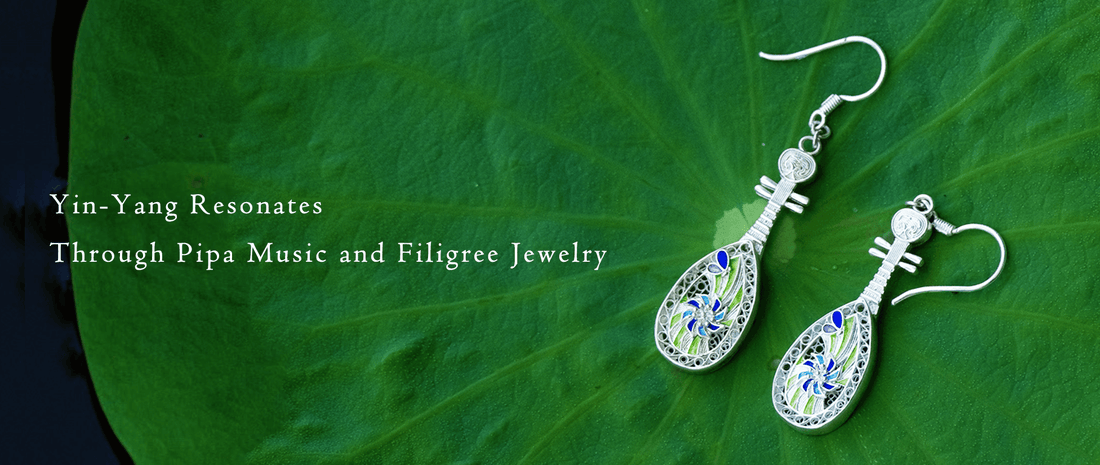
How Yin-Yang Resonates Through Pipa Music and Filigree Jewelry
ZOLANJEWELRYPartager
—— Jewelry isn’t just crafted, it’s composed, like music in motion.
Discover how Chinese silver filigree earrings echo the philosophy of Yin and Yang through the musical spirit of the pipa — a timeless harmony of structure and soul.
Introduction: Harmony Begins with Sound
In traditional Chinese music, sound is not merely heard — it is experienced.
Each tone resonates with the listener's inner world, echoing the pulse of nature and the harmony of yin and yang. The ancient scale was not just a musical system, but a cosmological map, each note imbued with elemental forces, and even silence itself is part of the composition.
From the five-tone pentatonic scale of Gong (宫), Shang (商), Jue (角), Zhi (徵), and Yu (羽), Chinese classical music has long mirrored the natural world and its most fundamental law: Yin and Yang.
Each tone carries either Yin or Yang properties — softness and strength, expansion and retreat, playing not just with melody, but with cosmic rhythm.
At ZolanJewelry, we find this same balance in material and craftsmanship. Music, after all, is a structure made of breath. We echo this principle through handcrafted adornments too.

I. Pipa: An Instrument of Yin-Yang Balance
The pipa, a four-stringed lute with over 2,000 years of history, is one of the most expressive instruments in Chinese music.
Its playing technique — fast plucking, arpeggios, and gliding fingering embodies contrast: tension and release, stillness and power.
Much like the Yin-Yang symbol itself, the pipa’s structure and play create harmony through motion:
● Gong (宫) – Earth – Yang – Centering
● Shang (商) – Metal – Yang – Strength
● Jue (角) – Wood – Yin – Growth
● Zhi (徵) – Fire – Yang – Energy
● Yu (羽) – Water – Yin – Flow
This system of five sounds becomes a musical cosmology, one that brings Heaven, Earth, and humanity into alignment, the result is a cosmic scale — where music reflects nature, time, and being.

II. Tracing the Roots of the Pipa
The earliest historical record of the pipa appeared in Shiming, a dictionary written by Liu Xi during the Eastern Han dynasty. It states:
"Pipa, originally from the Western Regions, was played on horseback. Pushing the hand forward is called 'pi,' pulling it back is 'pa' — the name imitates the motion of playing."
This passage reveals the pipa’s foreign origins, its association with nomadic culture, and the onomatopoeic roots of its name.
By the Wei and Jin periods, following the naming conventions of traditional Chinese plucked instruments like the qin and se, the characters "批把" were replaced with the more refined, musically rooted form "琵琶" (both using the radical for "string instrument"). At that time, the term referred broadly to all plucked string instruments.
Among them were:
● Round-bodied, straight-neck pipas (e.g., ruan),
● Pear-shaped, curved-neck four-string pipas (known as hu pipa ),
● Pear-shaped, straight-neck five-string pipas.

III. Pipa: Music of Bodhisattvas and Feitian
In the murals of Dunhuang, the pipa appears more frequently than any other instrument — over 700 depictions can be found in the Mogao Caves alone, making it the most illustrated among all musical instruments. Wherever music is depicted, the pipa is present.
From the Northern Liang period to the Yuan dynasty, its presence in the murals remained unbroken.
Over centuries of cultural evolution, the pipa became an inseparable part of Chinese civilization — a symbol of musical refinement and artistic spirit. Countless poems and timeless compositions, like stars scattered across the night sky, bear witness to its enduring brilliance.


It is these timeless themes that inspire the intricate craftsmanship behind ZolanJewelry’s Echoes of Dunhuang filigree earrings.
→ Explore More about Elements of Dunhuang
IV. Designs rooted in classical Chinese heritage
Our Echoes of Dunhuang Pipa Filigree Earrings were born from this sonic philosophy. Inspired by the celestial musicians of the Dunhuang frescoes, these earrings reinterpret the form of a pipa through the ancient Chinese craft of silver filigree (银花丝).
The elegant curve of each earring mimics the pipa’s silhouette.
The silver wires flow like plucked strings frozen mid-vibration.
Hollow spaces create rhythm — a balance of fullness (Yang) and emptiness (Yin).


V. The Art of Filigree: Craftsmanship with Spirit
Filigree is one of the oldest forms of metalwork in Chinese jewelry. It involves pulling pure silver into fine threads — as thin as 0.2mm — then twisting, soldering, and shaping them by hand into elaborate openwork.
This process is itself a study in contrast:
● Silver offers brilliance and strength — the Yang.
● Pattern offers softness, breath, and flow — the Yin.
Unlike heavy, solid jewelry, filigree appears airy and weightless, yet is constructed through immense precision. It is a form of discipline made beautiful — not unlike a musical scale practiced into grace.
🔗 Explore More about Chinese Filigree technique
→ Chinese Filigree Earrings: A Journey from Heritage to Modern Elegance
→ Woven in Silver: The Revival of Ancient Chinese Filigree Jewelry
Ⅵ. Culture You Can Wear
The Echoes of Dunhuang Earrings are part of a larger vision: to create cultural jewelry — pieces that don’t just follow trends, but honor the layers of meaning beneath tradition.
This is artisan jewelry that speaks not only to your eyes, but to your sense of time, history, and stillness. It connects the body to the mind, and the past to the now.
To wear them is to wear music.
To wear heritage.
To wear balance.


